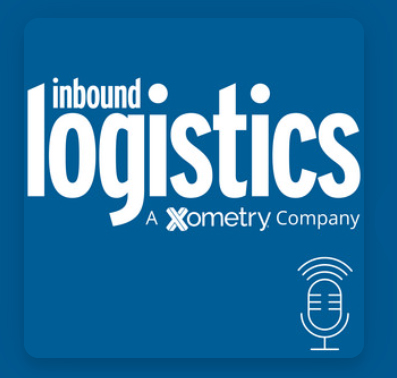
by logisticsplus | Jul 24, 2023 | News
Updates on Ukraine’s Supply Chain: What Continuing Efforts are Helping Ukraine Rebuild Their Supply Chain?
As the conflict in Ukraine continues into a second year, several business sectors of their economy are in dire need of repair and rebuilding efforts. Logistics Plus is focused on being active in rebuilding the country’s supply chain infrastructure by working with organizations like the U.S. – Ukraine Business Council to help support businesses in the region. Yuriy Ostapyak, Chief Operating Officer for Logistics Plus takes us through some of those efforts as well as some other strategic highlights coming from Logistics Plus.
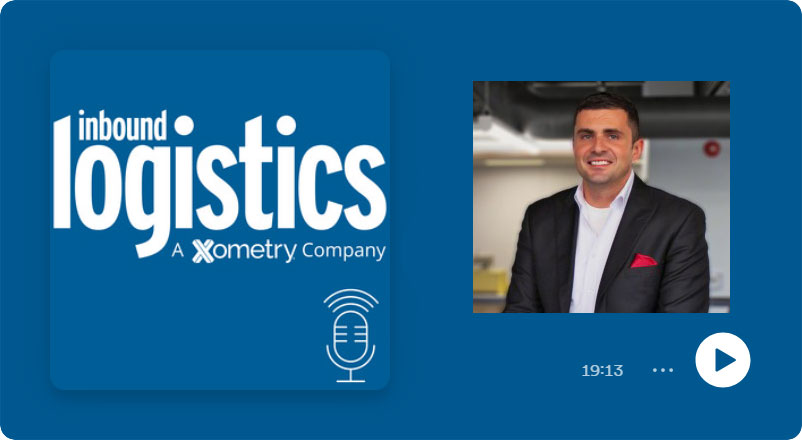
Click Above to Listen on Spotify

by logisticsplus | Jul 21, 2023 | News
 Logistics Plus Chief Operating Officer (COO) Yuriy Ostapyak was featured on the weekly Business Spotlight program on WPSE AM 1450/FM 107.1 Radio. Business Spotlight is a 30-minute program airing Fridays and Saturdays at noon. Each segment focuses on a business or organization that is impacting the region.
Logistics Plus Chief Operating Officer (COO) Yuriy Ostapyak was featured on the weekly Business Spotlight program on WPSE AM 1450/FM 107.1 Radio. Business Spotlight is a 30-minute program airing Fridays and Saturdays at noon. Each segment focuses on a business or organization that is impacting the region.
In this segment, Yuriy discusses his background, the company’s growth, efforts in Ukraine, recent certifications and partnerships, and more. You can listen to a replay of the interview on the Logistics Plus Podcasts page or by clicking below to listen on LP Radio on Spotify.

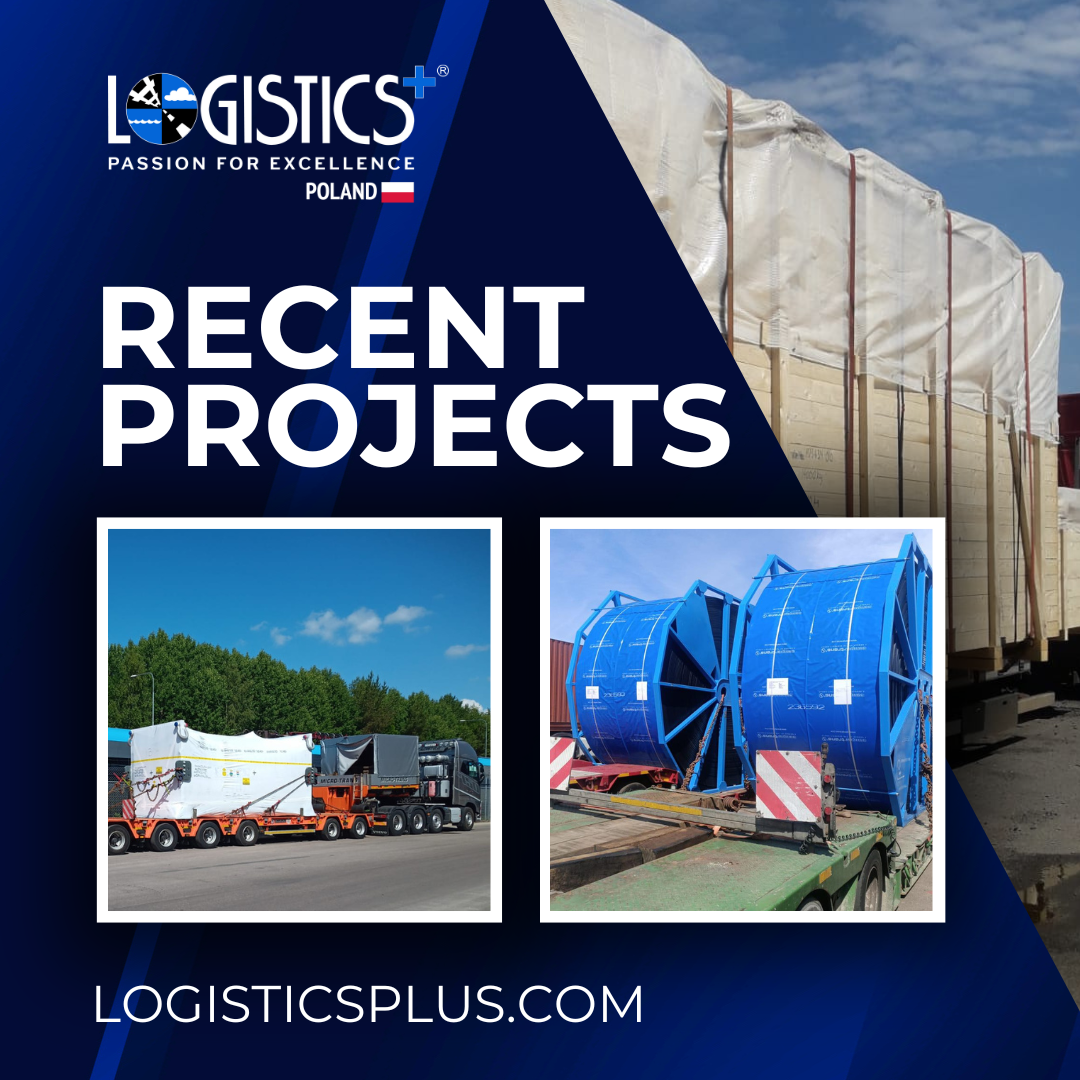
by logisticsplus | Jul 19, 2023 | News
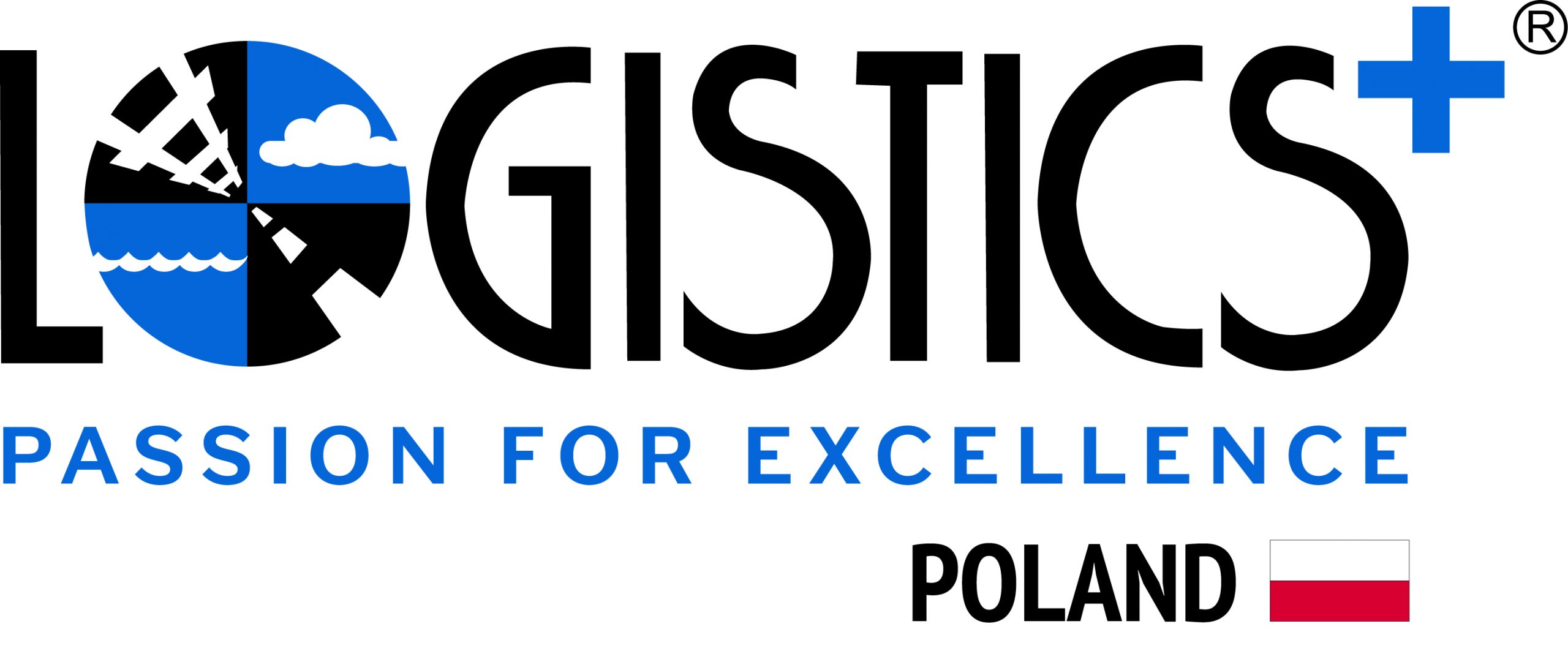 The Logistics Plus (LP) Poland project cargo team continues to support and manage projects across Poland and nearby countries. Here are three of the most recent projects handled by LP Poland.
The Logistics Plus (LP) Poland project cargo team continues to support and manage projects across Poland and nearby countries. Here are three of the most recent projects handled by LP Poland.
1) Cylinder & Accessories
The Logistics Plus Poland team managed a complex project involving a cylinder and accessories from Västerås, Sweden, to Wieluń, Poland. The cylinder measured 571 x 276 x 268 cm (L x W x H), and the largest piece of cargo weighed nearly 90 tons. As a part of the 4-week preparation process, several detailed studies were completed to ensure the bridges and roads in the route could accommodate the weight and dimensions of the shipment. A multi-axle trailer was used to transport the oversized cargo to meet all the requirements.
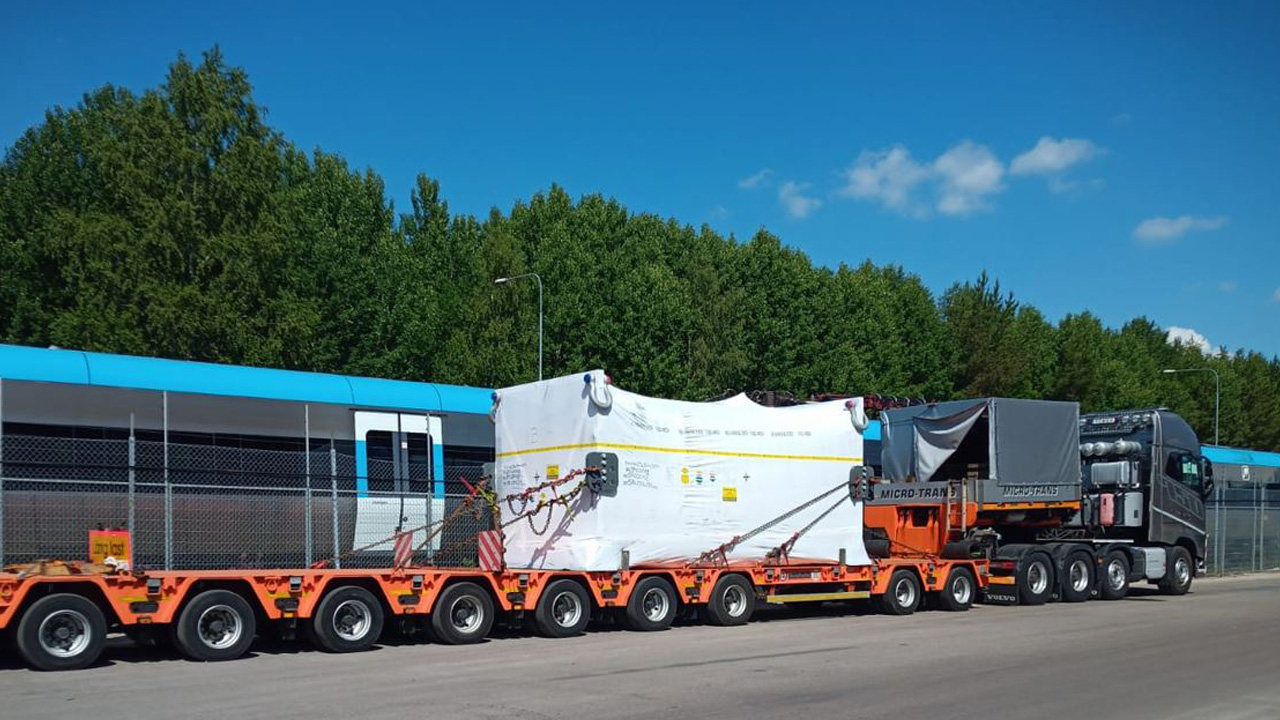

2) Baltic Hub Spools
The Logistics Plus Poland team completed the delivery of two spools of racetrack reels (open steel ellipse) from Rogowiec to Gdańsk. The spools measured 500 x 215 x 380 cm (L x W x H) and weighed 88 tons. Upon arrival, the spools were loaded directly onto a ship. The transport of another two units is currently in progress.
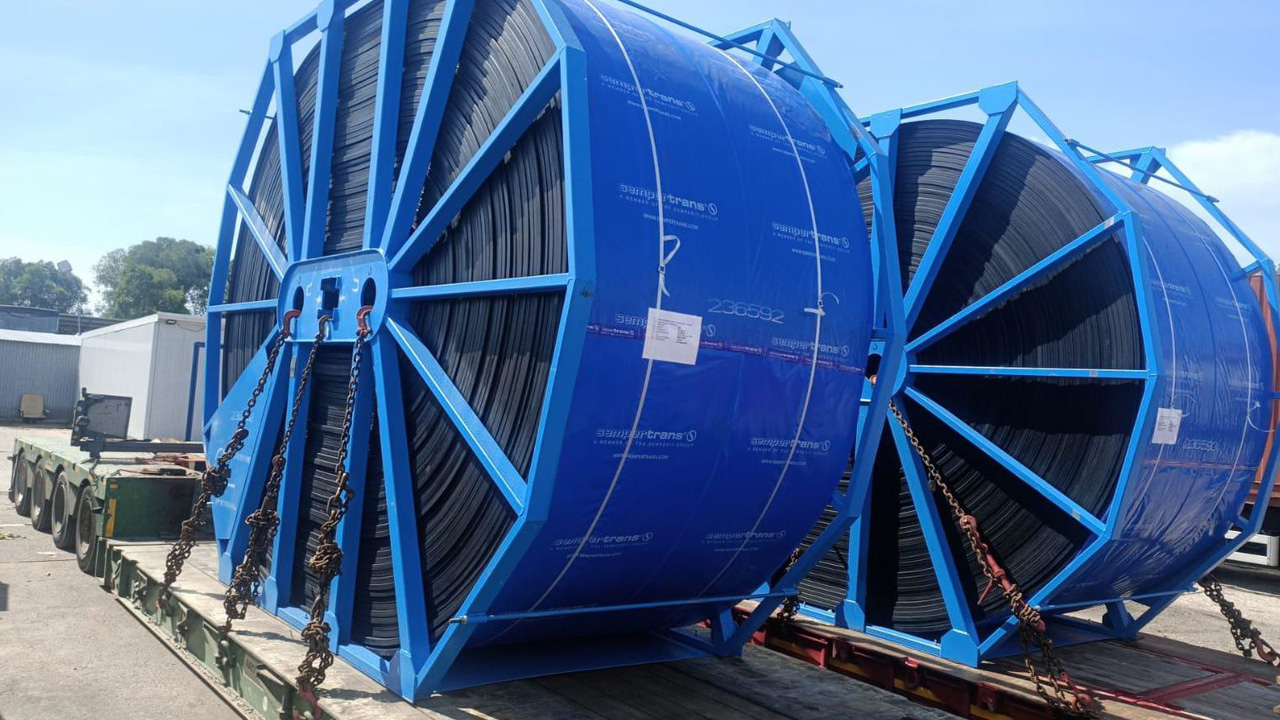

3) Reloading Compressors & Engines
The Logistics Plus Poland team continues to support Ukraine’s rebuilding efforts. This time, the LP Poland team organized the transportation of compressors and engines from Poland to Ukraine. This project involved discharging the cargo, container releases, drayage, cargo unloading at the warehouse, and customs clearance.
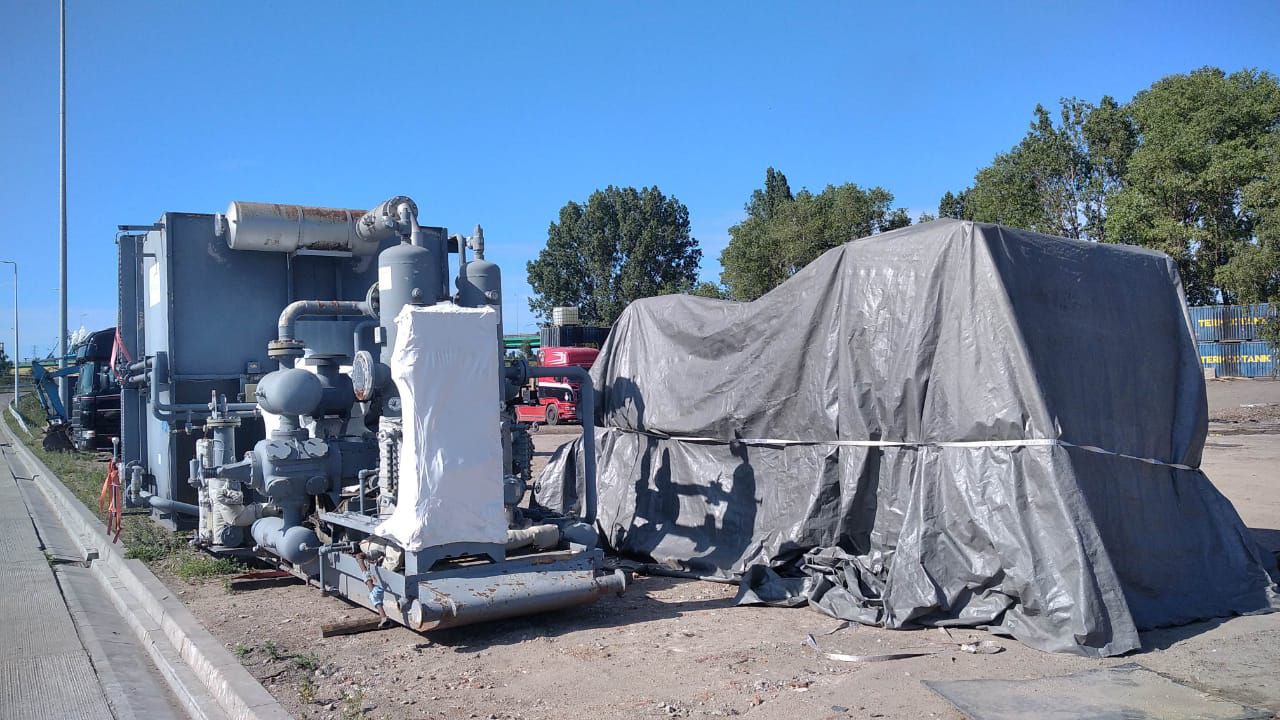

by logisticsplus | Jul 13, 2023 | News
 Logistics Plus has been selected as a Project Logistics Provider of the Year finalist for the 2023 Heavy Lift Awards presented by Heavy Lift & Project Forwarding International (HLPI) magazine. The Project Logistics Provider of the Year award is based on the following criteria:
Logistics Plus has been selected as a Project Logistics Provider of the Year finalist for the 2023 Heavy Lift Awards presented by Heavy Lift & Project Forwarding International (HLPI) magazine. The Project Logistics Provider of the Year award is based on the following criteria:
- Strategy for growth and enhancement of current services
- A deep understanding of your client base and their requirements
- An ability to adapt to changing market conditions
- A considered approach to safety and environmental issues within the organization
The 2023 Heavy Lift Awards selection ceremony will take place on October 25th at the Royal Lancaster Hotel in London. As the leading media presence for professionals involved in the heavy lift, break bulk, and project cargo industry, HLPFI has established the Heavy Lift Awards to recognize and reward excellence for complex logistics, transportation, and engineering projects around the world.
Click the flyer image below to view the complete Logistics Plus award entry:
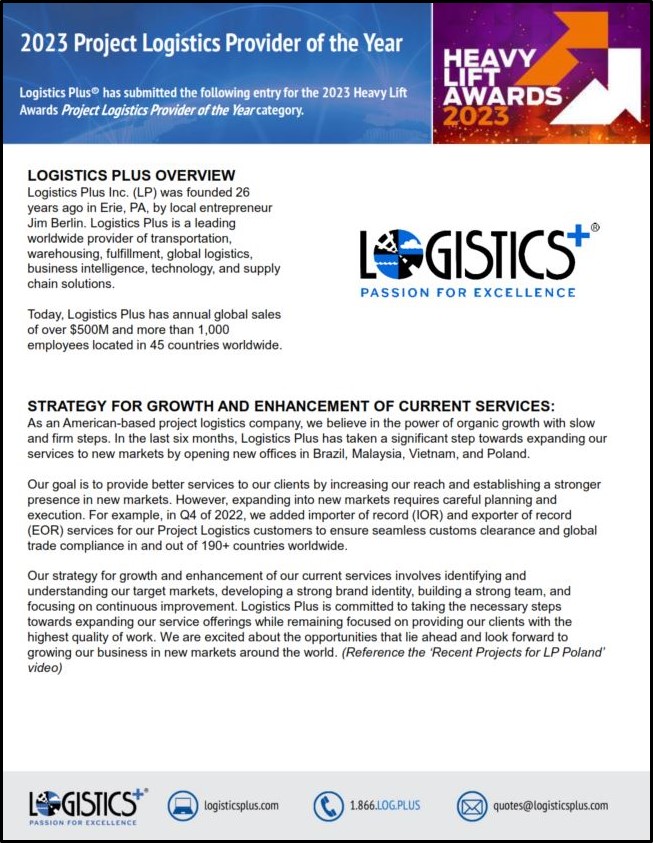



Bahadir Erdil, Global Projects Director, Logistics Plus
“This is an extraordinary achievement, and it speaks volumes about the caliber of professionals we have on our team. We stood out amongst the fierce competition, and it is because of your hustle, hard work, and unwavering dedication that we find ourselves in this remarkable position today. This recognition is a testament to (the Logistics Plus global projects team’s) resilience, expertise, and commitment to excellence. It acknowledges the countless hours we’ve invested, the sleepless nights, and the sacrifices made to ensure that we deliver exceptional service to our clients.
But this celebration is not just about the award itself. It is about the meaningful relationships we’ve built with our clients and partners, the impact we’ve made in their businesses, and the trust they have placed in us. Our success is a reflection of the collaborative spirit that permeates every aspect of our work, where each team member plays a vital role in achieving our collective goals.
I want to extend my heartfelt gratitude to our entire global projects team for your incredible contributions. Your passion, expertise, and unwavering commitment to excellence have brought us to this moment of triumph. It is the relentless pursuit of greatness that sets us apart and makes Logistics Plus an industry leader in Project Logistics … Our journey has only just begun, and I have no doubt that we will continue to soar to even greater heights in the future.”

by logisticsplus | Jul 13, 2023 | News
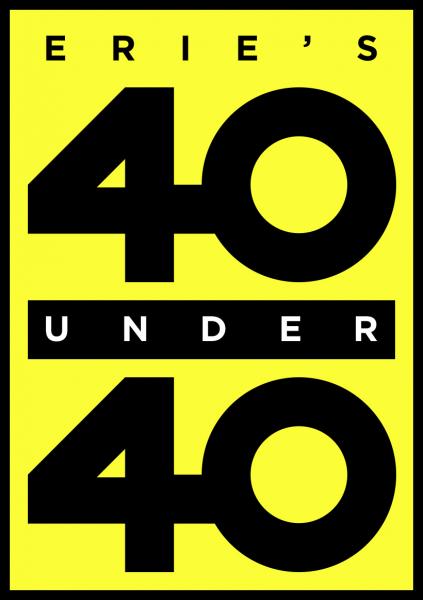 Logistics Plus Chief Operating Officer (COO) Yuriy Ostapyak was selected to Erie’s 40 Under 40 list, published by the Erie Reader. Erie’s 40 Under 40 is an annual list that features 40 young entrepreneurs, creative thinkers, and leaders shaping the future of Erie. For 2023, over 300 people who have had a hand in making Erie a more knowledgeable and fair place to live were nominated. Ultimately, only 40 winners were selected.
Logistics Plus Chief Operating Officer (COO) Yuriy Ostapyak was selected to Erie’s 40 Under 40 list, published by the Erie Reader. Erie’s 40 Under 40 is an annual list that features 40 young entrepreneurs, creative thinkers, and leaders shaping the future of Erie. For 2023, over 300 people who have had a hand in making Erie a more knowledgeable and fair place to live were nominated. Ultimately, only 40 winners were selected.
The full list of winners and write-up on Yuriy can be seen below or on the Erie Reader website at www.eriereader.com/article/eries-40-under-40-class-of-2023/yuriy-ostapyak
Yuriy Ostapyak, 39
COO, Logistics Plus, Inc.
 When your list of accomplishments includes starting out as a foreign exchange student college intern, working at a company in a small office of 30 employees, to then becoming COO and overseeing that same small office turn into a global company with over 1,000 employees, raking in half a billion dollars in revenue, AND climbing to the top of Mount Kilimanjaro, it is safe to say that Yuriy Ostapyak is the stuff of 40 Under 40 legend.
When your list of accomplishments includes starting out as a foreign exchange student college intern, working at a company in a small office of 30 employees, to then becoming COO and overseeing that same small office turn into a global company with over 1,000 employees, raking in half a billion dollars in revenue, AND climbing to the top of Mount Kilimanjaro, it is safe to say that Yuriy Ostapyak is the stuff of 40 Under 40 legend.
Born in Ivano-Frankivsk, Ukraine, Yuriy came to Erie and attended Villa Maria Academy, followed by Edinboro University, before returning to Ukraine to complete his graduate studies in international economics at the Kyiv National Economic University. And he has put his degrees to good use in Erie as he has become the chief operating officer of Logistics Plus, an international company headquartered here in Erie (at Union Station) that specializes in freight transportation, warehousing, fulfillment, global logistics, business intelligence, technology, and supply chain management solutions. All this is to say, Yuriy is very good at moving things around the globe.
And he is excited to keep Erie as his home base, “We love Erie, love the Erie community. We are committed to investing in Union Station as the long-term global headquarters of Logistics Plus. We are committed to making this a great place to work and serving the community through creating opportunities for young talent to thrive. We have already invested millions of dollars into our opportunity zone, and will continue to invest in making this an area that is welcoming and prospering.”
Yuriy’s love for Erie is also paired with a love for his birthplace, Ukraine. When Russia attacked Ukraine, Logistics Plus rallied support locally and beyond to Ukrainians, raising over $660,000 in relief and providing other aid. When he’s not busy fundraising or traveling the globe on behalf of his business, Yuriy enjoys hiking, taking walks, and playing golf.
Congratulations to Yuriy and the rest of Erie’s 40 Under 40 Class of 2023 on this well-deserved honor!


by logisticsplus | Jul 6, 2023 | News

NEWS PROVIDED BY
American University Kyiv
05 Jul, 2023, 09:00 ET
American University Kyiv Receives Significant Donation from Logistics Plus to Fund ‘Build Solid Futures’ Scholarships for Talented Ukrainian Students
TEMPE, Ariz., July 5, 2023 /PRNewswire/ — American University Kyiv (AUK), powered by Arizona State University, announces a major donation from Logistics Plus, Inc. to the Build Solid Futures scholarship program, which provides AUK students with merit-based, need-based, and wartime scholarships. This donation was made in partnership with the Institute of International Education (IIE). AUK is the first university in Ukraine based on American education standards and strives to create an optimum environment for young talent to develop their professional skills and drive progress while remaining in their homeland, Ukraine.
Logistics Plus, Inc. (LP) stands as a global leader in innovative supply chain solutions, driven by a “Passion for Excellence.” With over 1,000 dedicated employees and a presence in 45 locations worldwide, LP goes beyond customer service, actively uplifting the communities it touches. LP made a significant financial contribution to support Ukrainian youth amidst the challenges of a large-scale war, demonstrating their belief in education and their relentless commitment to making a positive impact. LP’s passion and determination align with AUK to forge a path towards a brighter future, inspiring hope and resilience in the face of adversity, while leaving an indelible legacy as a transformative force for Ukraine’s future.
“Logistics Plus is wholeheartedly committed to supporting the rebuilding efforts in Ukraine, actively standing with the nation during these challenging times. We have raised and donated over $1 million in total relief funds. Furthermore, we are actively raising funds to acquire and transport essential power generators while also focusing on other critical needs. Our most recent effort involved funding, procuring, and equipping two mobile trauma vans, enabling medics in Bakhmut to provide vital assistance. By contributing to the AUK Build Solid Futures scholarship program, we aim to fortify the support for Ukraine’s bright future by investing in the remarkable youth who will shape tomorrow’s Ukraine.” – said Jim Berlin, Founder & CEO of Logistics Plus.
For this fund-raising campaign in the USA, AUK is partnering with the Institute of International Education (IIE), a global not-for-profit organization that works with thousands of U.S. and international educational institutions and more than 29,000 students, scholars, and professionals each year.
“Every contribution to the future of Ukrainian students has a significant input in the global perspective. At AUK, we strive to help Ukraine to win the war and facilitate the recovery. Our fundraising campaign is aimed to expand access to high-quality education for promising youth from Ukraine, paying additional attention to the children of fallen Ukrainian heroes. We are very thankful to Logistics Plus and Jim Berlin for their tremendous efforts in helping Ukraine and joining us in this inspiring mission to help grow the future leaders of Ukraine,” outlined Dan Rice, AUK President.
Information on the scholarship and how to support it can be found at the link below. All contributions are 501c3 tax deductible within the United States and IIE provides all documentation for donors. https://www.iie.org/programs/american-university-of-kyiv.
The Build Solid Futures program provides AUK students with merit-based, need-based, and wartime scholarships that contribute to Ukraine’s young generation, its resistance and its commitment to freedom. AUK has created fully funded scholarships for veterans, widows/widowers and children of the Fallen Heroes – those who lost a parent in the war. A full four-year bachelor’s scholarship to pay 100% of a young person’s education is U.S. $32,000.
American University of Kyiv (www.auk.edu.ua) is offering a U.S. higher education standard in Ukraine through its partnership with Arizona State University (ASU), one of the largest universities in the U.S. and ranked by U.S. News & World Report as the most innovative university in the U.S. American University Kyiv delivers an American standard of excellence in higher education through its expanding portfolio of undergraduate, graduate, and lifelong learning programs.
Logistics Plus, Inc. (LP) (https://www.logisticsplus.com/) is a 21st Century Logistics Company™ and a leading worldwide provider of transportation, warehousing, fulfillment, global logistics, business intelligence, technology, and supply chain solutions. Logistics Plus was founded in 1996 and today has annual global sales of over $500M with more than 1,000 employees located in 45+ countries worldwide. It is recognized as one of the fastest-growing privately-owned logistics companies, a top 3PL provider, a top 100 logistics company, a top freight brokerage and warehousing provider, and a great place to work.
Institute of International Education (www.iie.org) was founded in 1919 and works with a range of corporate, government, and foundation partners across the globe to design and manage scholarship, study abroad, workforce training, and leadership development programs. IIE has a network of 18 offices and affiliates worldwide and over 1,300 member institutions. It administers over 29,000 scholarships in 180 countries annually, including the Fulbright Scholarships, Benjamin A. Gilman International Scholarship and many others.
SOURCE American University Kyiv





 Logistics Plus Chief Operating Officer (COO)
Logistics Plus Chief Operating Officer (COO) 





 Logistics Plus has been selected as a
Logistics Plus has been selected as a 



 Logistics Plus Chief Operating Officer (COO)
Logistics Plus Chief Operating Officer (COO) 


